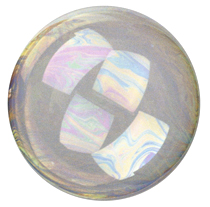DK Science: Light
Light makes the world seem bright and colourful to our eyes. Light is a type of electromagnetic radiation that carries energy from a source (something that makes light) at the very high speed of 300,000 kps (186,000 miles per second, or 670 million mph). Light rays travel from their source in straight lines. Although they can pass through some objects, they bounce off others or pass around them to make SHADOWS.

When light shines on a soap bubble, some of the rays reflect back from its outer surface. Others travel through the thin soap film and bounce back from its inner surface. The two sorts of reflected rays are slightly out of step because they travel different distances. They interfere with one another and produce colourful swirling patterns on the bubble’s surface.
Sometimes light seems to behave as though it carries energy in waves. Other times it seems to carry energy in particles or packets, called photons, fired off in quick succession from the source. Scientists argued for many years over whether light was really a wave or a particle. Now they agree that light can behave as either a wave or a particle, depending on the situation.
The powerful beam from a lighthouse illustrates that light travels in straight lines. Under normal circumstances, light never bends or goes round corners but travels in a perfectly straight path, making what is known as a light ray. Nothing can travel faster than light. The beam from a lighthouse travels its full length in a tiny fraction of a second.
Some objects transmit light better than others. Transparent objects, such as glass, let virtually all light rays pass straight through them. When you look at a glass of orange juice, you can see the juice inside very clearly. You can also see other things through the glass.
Translucent objects, such as plastic, allow only part of the light through. A plastic bottle lets some light rays pass through it. It is possible to see the orange juice inside the bottle, but you cannot see anything behind the bottle.
Opaque objects, such as metal, reflect all the light falling on them and allow none to pass through. When you look at a can of orange juice, all you can see is the can. It is impossible to tell, just from looking, whether or not the can has any orange juice in it.
Things that give off light are called light sources. When we see something, light rays have travelled from a source of light into our eyes. Some objects appear bright to us because they give off energy as light rays; these objects are said to be luminous or light-emitting. Other objects do not make light themselves, but appear bright because they reflect the light from a light source.
The Sun shines because it produces energy deep in its core. The energy is made when atoms join together in nuclear fusion reactions. The Sun fires off the energy into space in all directions in the form of electromagnetic radiation. Some of the radiation travels to Earth as the light and heat we know as sunlight. The Sun is a luminous light source because it makes energy inside itself.
The Moon shines much less brightly than the Sun. Unlike the Sun, the Moon does generate its own energy, so it produces no light of its own. We can see the Moon only because its grey-white surface reflects sunlight towards Earth. If the Earth passes between the Sun and the Moon, the Moon seems to disappear from the sky. This is called a lunar eclipse.
Some sea organisms can make their own light. This ability is called bioluminescence, which means making light biologically. Transparent polychaete worms such as this one make yellow light inside their bodies. In their dark seawater habitat they can glow or flash to scare off predators. Other bioluminescent sea creatures include shrimps, squid, and starfish.
Shadows are made by blocking light. Light rays travel from a source in straight lines. If an opaque object gets in the way, it stops some of the light rays travelling through it, and an area of darkness appears behind the object. The dark area is called a shadow. The size and shape of a shadow depend on the position and size of the light source compared to the object.
When you stand with the Sun behind you, the light rays that hit your body are blocked and create a shadow on the ground in front of you. When the Sun is high in the sky at midday, your shadow is quite short. Later on, when the Sun is lower, your shadow is much longer.
Shadows are not totally black. If you look closely at a shadow, you will see a dark area in the centre and a lighter area around it. The central dark area, called the umbra, occurs where rays of light from the source are totally blocked. The outer area, called the penumbra, is lighter because some rays do get through.
